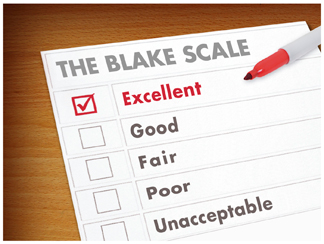
Editor's Note: Gary Blake, director of TheCommunication Workshop, contributed this article. Blake is also theauthor of “The Elements of Business Writing.”
|People are forever using the phrase, “On a scale from 1 to 10,with 1 being the least…” because it offers a range by which thelistener or reader can judge the relative importance of aparticular example.
|Yet, in writing, which claims professionals engage in as much ormore than professional writers, there is no accepted criteria bywhich we can universally judge a particular document as beingexcellent, very good, good, fair, or poor. This is because ratingwriting skills is more subjective than, say, the scientific mannerin which earthquakes are measured by the Richter magnitudescale.
|In criminal law, offenses are judged as infractions,misdemeanors, or felonies. In academia, A, B, C, D, and F areimmediately translatable to value judgments such as excellent,good, average, poor, and failing or “unacceptable.”
|A New 'Grading' System
For ease ofunderstanding, I have devised “The Blake Scale.” Similar to anacademic rating system, this scale uses five broad categories tohelp claims professionals discern the overall quality of onetypical page of a business-related letter—either template or freeform—report, e-mail, memo, or guidelines pertaining to bestpractices.
One caveat is this: Sometimes, because of particularcircumstances, a small infraction can mushroom into a full-scale“felony.” A quick example comes to mind. If I, as a writingconsultant, have a single typo in an e-mail to a prospect or aclient, then I may lose a job. If, however, I had been writing to astranger, then there would be no unfavorable consequences for mygaffe.
|If you feel that one typo could never loom large enough to causehavoc, then allow me to mention a big accounting firm that sent outits new brochure to masses of prospects and clients, only to laterdiscover that, on the brochure's cover, the term “Certified PublicAccountants” was rendered “Certified Pubic Accountants.”Now that is a pretty egregious error, the repercussions of which weshall not explore in this article.
|What follows is The Blake Scale, giving a general description ofthe characteristics of a document that is considered “unacceptable”(5) to one that is “Excellent” (1). The scale is broad, and lateron I will describe the typical kinds of errors found in each of thefive categories on the scale.
|Take Note
I would encourage you to makecopies of this article to disseminate to the various players inyour claims organization. Take a single page of a claims letter,memo, report, e-mail, or best-practices guidelines and assign it anumber based on the rating scale below:
5. Unacceptable. Only about one in fiftydocuments deserves to be rated “unacceptable.” This rating willmean that the document contains inaccuracies, a harsh tone, or anabundance of stylistic and factual errors that could lead to a DOIcomplaint, a distraction from the claims process, or even a badfaith lawsuit.
|In terms of organization and content, style, and level ofcorrectness, a “5” may exhibit the following characteristics:
- Inaccurate
- Harsh or untrusting tone
- Wordy and unclear
- Replete with errors in punctuation and grammar
- Redundant; poorly phrased; may have mistakes involving gaps inlogic
- Vague or inadvertent sexism, racism, ageism, or subjectivityregarding a claim's outcome
4. Poor. This document is difficult to read,with substantial problems in phrasing, paragraphing, or lengthysentences. It may contain many legalistic and old-fashionedphrases, as well as excessive wordiness.
- Confusing
- Few transitions
- Punctuation and grammatical errors
- Wishy-washy tone
- Ideas that lack supporting details
- Quotes are insufficient, excessive, or inaccurate; soundsimpersonal
3. Average. While this document gets its pointacross, it is often careless and filled with clichés orold-fashioned phrases. It may have lengthy sentences and paragraphsand a smattering of grammar and punctuation issues.
- The analysis is superficial
- Errors in word choice, spacing, punctuation, and/orspelling
- The introduction and conclusion may be weak
- Miscellaneous other errors, such as inconsistent capitalizationor abbreviations
2. Good. Basically gets thepoint across. May have minor stylistic flaws, a comma error or two.May require some copyediting.
- Clearly phrased
- Paragraphs are logical
- May have two or three stodgy phrases or clichés
- Sentences are generally concise, varied, and fluent
- Sounds personal
1. Excellent. This document is well-organized,flows well, and has no examples of old-fashioned phrases orpunctuation problems. Its sentences and paragraphs are relativelyshort, readable, and arranged carefully.
- Appropriate tone
- Clear and concise
- Helpful to the reader
- Well-phrased and well-organized
- Appropriate word choice
- Paragraphs are unified and coherent
- Follows standard rules of punctuation, grammar, andspelling
- Clear purpose
Characteristics of EachRating
No documents are alike. Rating adocument will rarely be instantaneous. Yet, after reading thousandsof claims documents, I believe a claims professional can quicklyrate a document, become more aware of the specific type of writingissues that commonly occur in the field, and judge the relativeseverity of each problem.
As you work with the scale, you will develop your own way ofapplying its basic tenets to the particular document you arereviewing. Something about the seriousness and frequency of theissues you notice will guide you to make a determination. Fewdocuments will be awful; few will be free of all writingproblems.
|Here are the types of issues I notice in each of the fiveratings. Some may be present in any of the ratings,occurring once in the best of documents and many times in theworst.
| Unacceptable
Unacceptable
One out of every fifty or sodocuments may be incendiary and need immediate intervention. Amongthese are letters that are discoverable in which ageism, racism, orsexist or demeaning remarks are evident and may be exploited byopposing counsel. Subjective language may demonstrate that thewriter has already become biased before all the facts are in.Sometimes a harsh or even belligerent tone makes a documentunacceptable. It may alienate a client, top manager, or opposingcounsel.
One letter, filled with numerous punctuation and grammar errors,became “Unacceptable” when the reader, an educator, not only tookoffense to it but also corrected the errors and mailed a copy ofthe letter to the carrier's CEO.
|Examples from unacceptable documents:
|“We have very differing opinions about who has been draggingtheir feet on this claim in terms of bringing it to aconclusion.”
|“The policyholder was discussing something with threeMexican-looking guys…”
|Lack of objectivity, taken from a claims file: “We havea favorable interview from a neighbor that our insured's driver wasnot supposed to use the car.”
|Even more subjectivity: “We can only hope that theplaintiff's condition continues to deteriorate …We think thisperson will die of cancer and we will be off the hook.”
|Belligerent tone: “Reality has finally set in, and yourclient, his family, and even you now realize the theories ofliability that you have relied upon in the past are not applicableto this claim.”
|Embarrassing word choice: “We want to settle your claimas expediently as possible.”
| Poor
Poor
A combination of poor wording,questionable punctuation and grammar, as well as inappropriatetone.
Examples are as follows:
“Dear Mr. & Mrs. Smith;
|We have given careful consideration to your claim arising out ofthe above-captioned incident.
|Our investigation of the facts indicates that there is noafforded coverage for your vehicle from the auto policy of Mr.XXX. The stipulation of the policy is that of an insuredusing a “non-owned automobile.” The use of the “non-ownedautomobile” must be under the scope of the owner'spermission. This scope is totally absent in this situation,as XXX had not the authority to let anyone drive the auto. The auto was driven without permission from the owners, in thiscase the two of you. The auto was also driven without yourknowledge of the action being permitted. We have anon-permissive driver driving a non-permissive auto.
|Therefore it will be necessary we decline the payment of yourclaim.
|If you feel we are in error and can provide proof that coverageshould be afforded for the damage please let me know, we will behappy to reconsider our position.
|While a decision on our liability for this claim must of courseawait the completion of the investigation, it appears conceivablethat some policy defenses may be applicable with respect to thismatter in which case litigation would be a distinct possibility.”
|***
|Taken from a claims letter: “This letter will follow upyours of March 17 …”
|***
|Run-on sentence: “According to the last paragraph ofyour e-mail shown below you confirmed the total audit experience is7,100 this is the number we based our revised audit on.”
|Other issues may include: overuse of parentheses, notputting comma after the full date, unnecessary capitalization,using an ampersand in “Dear Mr. and Mrs. Smith:” or not respondingto every issue brought up in a complaint forwarded by theDepartment of Insurance.
| Fair
Fair
Examples:
“This is to confirm that XXX Insurance Company has received yournotice of loss regarding the theft of your tools, and ourconversation of December 29th, 2003.”
|***
|Just one example, such as the following lengthy paragraphfilled with legalese, can put a document into the “Fair” category:
|“Inasmuch as the late reporting of this loss may have impairedAcme Insurance Agency's ability to determine the origin and extentof damage and whether coverage exits for the loss, the purpose ofthis letter is to advise you that any action taken by anyrepresentative of Acme Insurance Agency in connection with theinvestigation of the aforesaid reported wind and water damageclaim, including the investigation of all facts pertaining theretosuch as the cause, loss or damage resulting therefrom shall in nowway change, waive, invalidate or forfeit any of the terms,conditions and requirements of the above captioned policy ofinsurance.”
|Occasional issues with tenses, often associated with peoplefor whom English is a second language: “I have not receivethis information.”
|Occasional slash constructions: “he/she” “and/or”
|May contain the weak and presumptuous: “Thank you inadvance for your cooperation”; or the cliché: “If you haveany questions, please do not hesitate to call me.”
| Good
Good
Example:
September 12, 2011
|Ms. Alisa Craig
|6 McDermott Street
|Seattle, WA 98767
|INSURED: Mason Group/Cedar Hill Apartments
|POLICY NUMBER: 989898
|DATE OF LOSS: May 19, 2011
|ABC CLAIM NUMBER: POL09990
|Dear Alisa,
|Jahn Adjusting was retained by ABC Insurance to investigate theclaim for the damage to the building as a result of fire at theloss location of 22 Foothill Road, Bellevue, WA 98678.
|This letter serves to inform you that a $100,000 advance wasissued and received by you on Thursday, September 7, 2011, towardthe building portion of your claim. At your request we arenotifying you in writing of the above mentioned payment(s).
|The foregoing reservation is predicated upon the facts andcircumstances known at this time. ABC Insurance expressly reservesits right to amend this reservation at a later date should it beappropriate.
|If you have any questions in regards to your claim, pleasecontact your Public Adjuster, Karen Seider, at (543) 324-5555.
|Sincerely,
|Copy: _____________________
|Note: In the letter just quoted, the “RE” line,salutation, inside address, and closing are all correctly done.
| Excellent
Excellent
To earn a “1” or “Excellent,” adocument needs to be free of even the smallest problems. The insideaddress, RE line, salutation, and closing are perfect. Sentencesand paragraphs are not too long and are easy to read. In fact, ifyou were to read this document aloud, it would sound warm andnatural as the human voice.
Here are ten earmarks of an excellentletter:
|1. It gets right to the point
|2. No old-fashioned phrases (e.g., “enclosed please find,” “asper”)
|3. No redundant expressions
|4. No wordiness or vagueness
|5. Logical flow of ideas
|6. Appropriate transitions
|7. No spacing, spelling, abbreviation, or capitalizationerrors
|8. Apt word choice
|9. Friendly
|10. Conversational but not containing slang orcolloquialisms
|I should mention that only about one in fifty letters I reviewmerit the category of “Excellent.” The BlakeScale and the examples used to illustrate each of its five ratingswill help diagnose and solve the types of writing problems thatsubtly sabotage claims handling.
|To be proactive in tackling claims-writing problems will preventa million- or billion-dollar carrier, TPA, or independent agencyfrom experiencing everything from embarrassment to a bad-faithlawsuit. Clear, precise writing disarms the opposing attorney whomight enjoy reading a poor claims letter aloud in court. Effectivewriting gives you the edge because it demonstrates that you arefluent, organized, and authoritative.
Want to continue reading?
Become a Free PropertyCasualty360 Digital Reader
Your access to unlimited PropertyCasualty360 content isn’t changing.
Once you are an ALM digital member, you’ll receive:
- All PropertyCasualty360.com news coverage, best practices, and in-depth analysis.
- Educational webcasts, resources from industry leaders, and informative newsletters.
- Other award-winning websites including BenefitsPRO.com and ThinkAdvisor.com.
Already have an account? Sign In
© 2024 ALM Global, LLC, All Rights Reserved. Request academic re-use from www.copyright.com. All other uses, submit a request to [email protected]. For more information visit Asset & Logo Licensing.








